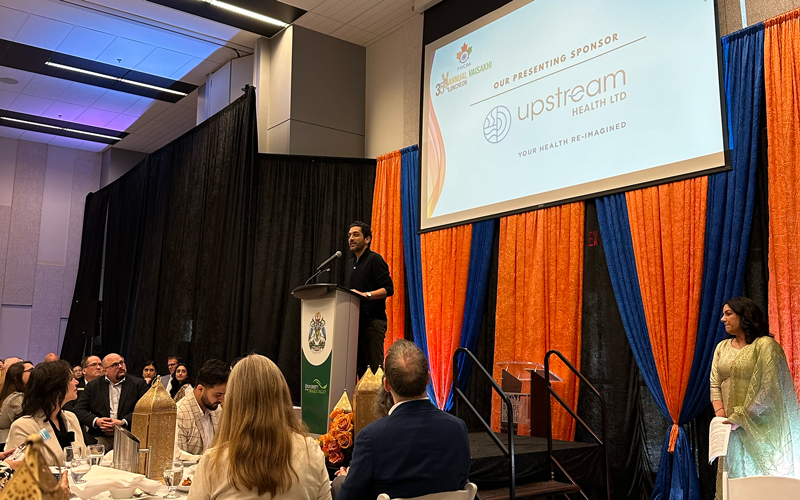It matters that we know how special we really are.
I had the fortune of speaking at a South Asian luncheon event for 350 in the Fraser Valley. I spent my time highlighting what most of us don’t know.
Quite unfairly, South Asians experience health disparities when compared to other demographics, yet these inequities go largely unnoticed. Our unique health concerns are often overlooked, as mainstream medical guidelines don’t fully account for our distinct requirements.
The rule book is not developed with us in mind.
As a group, we are less likely than others to say we feel healthy. Maybe that’s because we aren’t told what we need to be doing to prevent the specific illnesses we suffer.
We are a relatively young community. The average age of South Asians in Metro Vancouver is 40 – the age we start to see the development of preventable chronic diseases.
Let me paint a picture of the stark differences we face.
Imagine a white person standing 5 feet 11 inches, weighing 215 lbs. Next to him stands an equally tall Indian man who weighs 175 lbs. Both have identical elevated risks of heart disease because both are considered obese.
How is this possible?
Body Mass Index (BMI) is a metric combining our height and weight. Standard of care medicine uses this to classify risk of disease. A BMI of 30 for a person of European descent meets the cutoff for “high risk” of heart disease as well as many other related conditions. All things being equal, the same risk occurs for a South Asian at a BMI of 23.
Pound for pound, we are absolutely not equal.
What might be worse, a white European qualifies for medical attention and for treatment. The Indian, doesn’t. We are often not offered treatments until it’s too late to reverse the problem because life saving drugs are both offered and covered by insurance at white people cutoffs.
South Asians are kept in the dark about our health needs.
Nobody tells us that:
- We have the same cholesterol problems at a BMI of 22 as white Europeans do at a BMI of 30.
- We have the same difficulty controlling our blood sugar at a BMI of 21 as a white European would at BMI 30.
- To prevent metabolic diseases our waist needs to be 31 inches when their waist can be 34.
We carry more fat and have higher waist sizes at lower weights. When we look deeper, we have increased hidden fat, but we are not offered scans to show us how much of this danger lies beneath the surface. We don’t meet white people cutoffs.
Nobody tells us we need more exercise. If Europeans need 150 minutes a week to be at a lower risk of heart attack and stroke, we need 230 minutes. That’s 15 extra minutes per day. At the same time we are the lowest exercising group in Canada. We need more, get less.
Nobody tells us that menopause is on average at age 48 for South Asian women, but 51.5 for white Europeans. The onset for heart disease risk begins a 3 whole years earlier for South Asian women than it does for others. We call this the critical window to screen (and treat) women for these diseases.
South Asian women are – you can guess – often missed.
The screening and treatment gap widens even further when we look at the prevalence of fatty liver in South Asian menopausal women. Not long after menopause, it skyrockets, surpassing even the absolute number of men with the condition.
And then there’s iron.
Surprising, and sad enough that 30% of white women are iron deficient. A whopping 60% of South Asian women are iron deficient.
Owing to a number of challenges within our culture, a lot of women are living their lives, wondering whether their exhaustion, hair loss and anxiety is just part of being a woman. And many times they are told this is the case. Meanwhile, 100% of the time, this is completely false. South Asian women should regularly have their ferritin (iron) levels checked. Indians who are chronically iron deficient should also be checked for celiac disease since we have higher rates than others too.
The iron deficiency number is even higher and more complicated in pregnancy. Iron deficiency in pregnancy is associated with poorer cognitive development in children. Children born to iron deficient mothers are more likely to suffer from chronic anemia as adults. These problems are intergenerational.
It’s also puzzling that our children are diagnosed more often and at earlier ages with inflammatory conditions like Crohn’s and Colitis. We have a lot of ideas as to why, but nothing concrete yet to develop strategies to change this reality. One reason may be that South Asians have lower Vitamin D levels than others, but don’t get offered testing to know how low we get.
Testing can only happen if healthcare providers are aware that it needs to. We only become aware if guidelines change to reflect our differences. The medical system says it is too expensive to change the guidelines to help South Asians because it would mean more money for testing, insurance and drug coverage. I am hoping we can change that. If we don’t it will cost us much more than money. As a group, it matters that we know how special we really are. Our lives depend on it.
When surveyed, the biggest complaint South Asians have about healthcare is that doctors don’t listen to us.
If you need someone to speak to, I’m all ears.
Dr. Bobby Parmar
Naturopathic Physician






